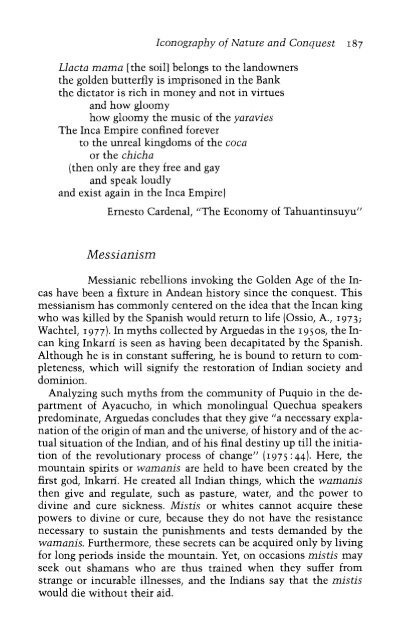The Devil and Commodity Fetishism in South America - autonomous ...
The Devil and Commodity Fetishism in South America - autonomous ...
The Devil and Commodity Fetishism in South America - autonomous ...
Create successful ePaper yourself
Turn your PDF publications into a flip-book with our unique Google optimized e-Paper software.
Owners <strong>and</strong> Fences 85<br />
attention. <strong>The</strong> foreman dem<strong>and</strong>ed that he keep work<strong>in</strong>g. <strong>The</strong><br />
man asked for water, but the boss said he should get up <strong>and</strong><br />
work. He was still ly<strong>in</strong>g <strong>in</strong> the cane field when the truck came<br />
to take the workers back to town, <strong>and</strong> they forgot him. He laid<br />
there all weekend. When they came back on Monday he was<br />
almost dead. <strong>The</strong>y took him to hospital <strong>and</strong> gave him serum.<br />
But he died a little later. <strong>The</strong> workers are so preoccupied with<br />
gett<strong>in</strong>g enough money to live on that they just concentrate on<br />
what they are do<strong>in</strong>g. <strong>The</strong>y don't have time to th<strong>in</strong>k about anybody<br />
or anyth<strong>in</strong>g but what they are do<strong>in</strong>g.<br />
Shortly afterwards, the man who recounted this left the plantation<br />
<strong>and</strong> devoted himself full-time to his mother's plot. He reasoned that<br />
although he made less money it was worthwhile because the <strong>in</strong>tensity<br />
of the work was so much less.<br />
In the valley over the past fifteen years a fivefold to tenfold <strong>in</strong>crease<br />
has occurred <strong>in</strong> the large-scale cultivation of crops other than<br />
sugarcane, <strong>and</strong> these crops are exclusively worked by the contractor<br />
system—the difference with the cane be<strong>in</strong>g that a high proportion of<br />
workers <strong>in</strong> these crops are local women <strong>and</strong> their children. <strong>The</strong> labor<br />
contractors prefer to employ women <strong>and</strong> children. <strong>The</strong>y say they are<br />
"more tame," will work for less, <strong>and</strong> do as they are told. <strong>The</strong>y have<br />
to, because the burden of child care <strong>and</strong> feed<strong>in</strong>g <strong>in</strong>creas<strong>in</strong>gly falls<br />
on the women, who are pa<strong>in</strong>fully conscious of the hungry <strong>in</strong>fants<br />
await<strong>in</strong>g their rice at nightfall. Life histories <strong>and</strong> genealogies <strong>in</strong>dicate<br />
that the two-generational s<strong>in</strong>gle woman-headed household <strong>and</strong><br />
short-lived liaisons between women <strong>and</strong> men have become <strong>in</strong>creas<strong>in</strong>gly<br />
common over the past thirty years. <strong>The</strong> marriage rate has<br />
halved s<strong>in</strong>ce 1938. <strong>The</strong>se women <strong>and</strong> children laborers are often<br />
known as iguazas <strong>in</strong> reference to the migratory ducks that pick the<br />
seed ly<strong>in</strong>g <strong>in</strong> the fields. Some people derive most of their <strong>in</strong>come<br />
from such glean<strong>in</strong>g, eat<strong>in</strong>g or sell<strong>in</strong>g the gra<strong>in</strong> they f<strong>in</strong>d loose <strong>in</strong> the<br />
soil. But despite what the contractors say, these women do strike on<br />
occasions <strong>and</strong> do so directly <strong>and</strong> spontaneously without organized<br />
leadership, walk<strong>in</strong>g off the fields when the rate offered is <strong>in</strong>sult<strong>in</strong>gly<br />
low.<br />
<strong>The</strong> majority of the casual laborers are locals of peasant descent<br />
<strong>and</strong> born <strong>in</strong> the area. To vary<strong>in</strong>g degrees they rely on their plots for<br />
some of their livelihood. Many oscillate between peasant farm<strong>in</strong>g<br />
<strong>and</strong> work<strong>in</strong>g for contractors, whereas others have their immediate<br />
families supply<strong>in</strong>g part of their subsistence from their plots. Around<br />
three-quarters of the so-called permanent fraction of the wage-labor<strong>in</strong>g<br />
force are black immigrants from the relatively isolated jungles of
















